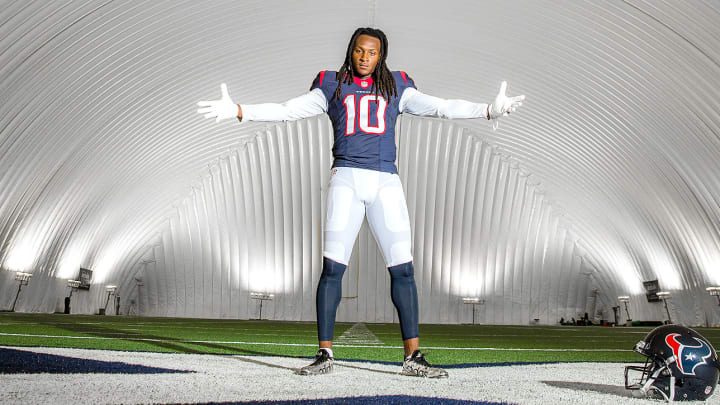Despite rotating cast of QBs, the sky is the limit for WR DeAndre Hopkins

When DeAndre Hopkins faced off against Seahawks cornerback Richard Sherman as a rookie in 2013, the encounter was forgettable in many ways.
Andre Johnson was still the primary receiver for the Texans, so Sherman lined up across from Hopkins only a handful of times. Hopkins caught just two passes for 27 yards, and neither came against the corner, who was in the midst of three straight All-Pro seasons.
But Sherman saw enough that afternoon—the stutter-and-go route that left him stumbling and burned; the precise out cut that forced Sherman to grab Hopkins's shoulder pads to stay close; another stutter-and-go, after which Sherman had to put both arms out to slow Hopkins down—that he pulled the 21-year-old aside after Seattle's overtime win.
"He was open more times than he got the ball, I would definitely say that," Sherman says, the matchup still fresh in his mind. "You could just feel him as you're playing the game: his intensity, his aggression, his athleticism, his explosiveness. I was like, Dang, he's right on the verge of being one of the best in this league—if they target him enough, give him his shots, he's going to be a monster. I told him that after the game. I remember telling him, 'Just keep pressing and keep working, and you'll get everything you deserve.'"
Driven by his own expectations, Trai Turner has the Hall of Fame on his mind
Now Hopkins, the No. 27 pick out of Clemson, is ready to fulfill Sherman's prophecy. He announced his presence in 2015 with 111 receptions for 1,521 yards (both third in the league) and 11 touchdowns (tied for seventh), and he was named second-team All-Pro. If Hopkins catches 104 passes this season, he'll have the most receptions by any player in his first four seasons.
Compared with some of his contemporaries, Hopkins has succeeded despite having—to be kind—journeymen at quarterback: Matt Schaub, Case Keenum, Ryan Fitzpatrick, Ryan Mallett, Tom Savage, Brian Hoyer, T.J. Yates and Brandon Weeden. With Nate Washington and Cecil Shorts as his running mates last season, Hopkins became the only receiver in NFL history to have 100-yard games with four different quarterbacks. In fact, he might be the only quarterback-proof wideout in the game.
"A lot of guys, I don't want to say names, their starting quarterback isn't in there, and they fall off," says Hopkins. "To me, a true receiver wants to get the job done no matter who's in there. I think I'm the best receiver in the league. That's the mentality I will always have, because I know what I'm capable of. Say I'm not. Honestly. I'm the only guy to have 100 yards with four different quarterbacks. I don't know if that will happen again."
NFL Crystal Ball: Predicting playoffs and award winners for 2016 season
Despite the fantasy-football-fueled rules changes to help passing games, this is not an easy time to be a dominant receiver. The field is flooded with more defensive backs than ever, and even the top defensive minds, such as Bill Belichick and Dick LeBeau, have largely surrendered their favored zones for man-to-man coverage on the outside. Quarterbacks and receivers are more accurate (teams completed 63.0% of their passes last season, setting a record for the third year in a row) because they are throwing more in the college ranks. If your philosophy on D is to sit back and wait for the quarterback to make a mistake, you're in for a long season.
Beating man coverage is a little easier if you're on the preferred quadrant of the size-speed chart—think Dez Bryant, A.J. Green, Calvin Johnson, Julio Jones and Brandon Marshall—or if you're a jitterbug like Odell Beckham Jr., Antonio Brown and Julian Edelman. A 6' 1", 207-pounder who ran 4.57 in the 40, Hopkins doesn't have those sorts of gifts, but he may be the toughest to blanket one-on-one. He took Darrelle Revis, still known as the league's best cover corner, to the cleaners last season: four catches for 98 yards, including a 61-yard touchdown, and he was open but overthrown twice more. At Jets training camp last month, when Brandon Marshall reminded Revis of his poor performance against Hopkins, Revis slapped Marshall, and teammates had to break up the ensuing scuffle.
"He does have good size, and he has excellent playing strength," says Texans coach Bill O'Brien of Hopkins. "On top of all that, his catch radius is ridiculous. He's got great hands. He can make a one-handed catch, he can make the jump ball, pick it off the top of another guys' head. Even if you're double-teaming him, unless the second guy really is tight to him, he's still going to have a chance to make a play because his body control is exceptional."
Start 'Em, Sit 'Em: How to set your fantasy football lineups for Week 1
Hopkins does have unusually long arms (33 3/8") and 10-inch hands, and he has extra space between the metacarpals in his palm and the proximal bones at the base of his fingers. You could say he was put on Earth to catch footballs.
There's one other way in which Hopkins excels, and it will enable him to continue his rise. "Man, he's a dawg, he's a competitor, and he's been that way ever since I played him," says Sherman. "You can't measure a man's dawg by his size, speed, his measurables. It takes the ability to overcome adversity, it takes the ability to get knocked down, taste your own blood, get back up and keep fighting. He has all that. He has the things you can't coach, the things you can't teach. If you give him a great quarterback, a consistent quarterback, I think the sky is the limit."
